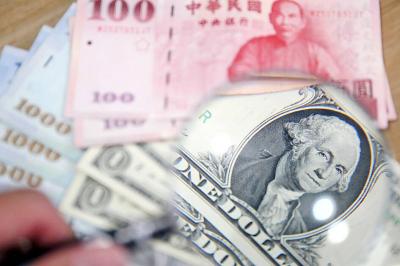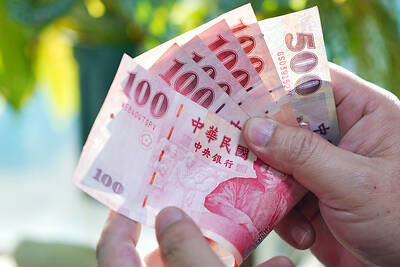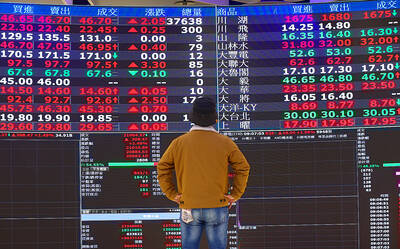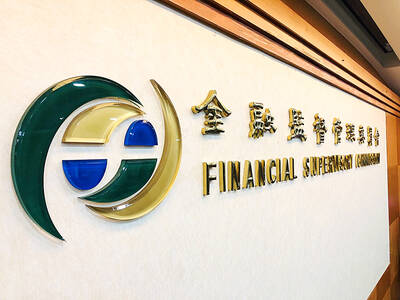Samsung Electronics Co has predicted that the long-depressed memorychip market is heading for recovery, after reporting profit for the third quarter well ahead of analysts’ estimates.
The South Korean giant’s net income totaled 5.5 trillion won (US$4.1 billion) in the third quarter, more than double expectations of 2.52 trillion won, data compiled by Bloomberg showed.
A significant chunk of the profit, 1.9 trillion won, came from a one-time income tax gain.

Photo: AFP
Samsung’s chip division posted a 3.75 trillion won operating loss, narrower than the 4.4 trillion won loss a quarter earlier.
On a conference call, Samsung executives said that artificial intelligence (AI) is driving demand in the technology industry and memorychip inventories are declining after peaking in May.
“It’s very encouraging to see that chip inventory is coming down,” said Park Sang-hyun, an analyst who publishes on the SmartKarma platform. “However, we still need more evidence that ... memory demand is set to recover next year.”
South Korea’s largest company said it plans to trim capital expenditure for the semiconductor division to 47.5 trillion won this year, from 47.9 trillion won last year. Overall, its capital spending for this year is expected to reach a record 53.7 trillion won, compared with 53.1 trillion won last year.
The company’s display division more than doubled operating profit to 1.94 trillion won from the previous quarter.
Samsung said the increase was due to the release of flagship models from major customers, without identifying them.
Samsung’s division that includes its mobile business posted an operating profit of 3.73 trillion won, aided by new Galaxy Z foldable smartphones launched in the second half of this year.
Samsung mobile division vice president Daniel Araujo said that foldables would be “a key engine” for short-term growth.
“We’re open to the possibility of expanding the foldable category from only smartphones into other product groups like laptops and tablets,” Araujo said.
Samsung voiced optimism for the memorychip market overall.
It predicted that prices would rise this quarter compared with the third quarter.
Overall demand for such components would rise with the development of AI applications, such as OpenAI’s ChatGPT, it said.
Samsung executives said they would continue to invest in high-density memory chips, particularly in high-bandwidth memory (HBM), with plans to increase capacity by 2.5 times next year.
HBM is a type of advanced memory chip that stacks DRAM to process data more quickly. It works in tandem with AI hardware such as Nvidia Corp’s graphics accelerators, which speed up data processing for intensive tasks such as training AI models.
“We have already completed supply talks for next year with our key customers for this volume,” Samsung memory division executive vice president Min Jae-june said on the conference call. “We expect the recovery trend in the memory market to accelerate.”

The US dollar was trading at NT$29.7 at 10am today on the Taipei Foreign Exchange, as the New Taiwan dollar gained NT$1.364 from the previous close last week. The NT dollar continued to rise today, after surging 3.07 percent on Friday. After opening at NT$30.91, the NT dollar gained more than NT$1 in just 15 minutes, briefly passing the NT$30 mark. Before the US Department of the Treasury's semi-annual currency report came out, expectations that the NT dollar would keep rising were already building. The NT dollar on Friday closed at NT$31.064, up by NT$0.953 — a 3.07 percent single-day gain. Today,

‘SHORT TERM’: The local currency would likely remain strong in the near term, driven by anticipated US trade pressure, capital inflows and expectations of a US Fed rate cut The US dollar is expected to fall below NT$30 in the near term, as traders anticipate increased pressure from Washington for Taiwan to allow the New Taiwan dollar to appreciate, Cathay United Bank (國泰世華銀行) chief economist Lin Chi-chao (林啟超) said. Following a sharp drop in the greenback against the NT dollar on Friday, Lin told the Central News Agency that the local currency is likely to remain strong in the short term, driven in part by market psychology surrounding anticipated US policy pressure. On Friday, the US dollar fell NT$0.953, or 3.07 percent, closing at NT$31.064 — its lowest level since Jan.

The New Taiwan dollar and Taiwanese stocks surged on signs that trade tensions between the world’s top two economies might start easing and as US tech earnings boosted the outlook of the nation’s semiconductor exports. The NT dollar strengthened as much as 3.8 percent versus the US dollar to 30.815, the biggest intraday gain since January 2011, closing at NT$31.064. The benchmark TAIEX jumped 2.73 percent to outperform the region’s equity gauges. Outlook for global trade improved after China said it is assessing possible trade talks with the US, providing a boost for the nation’s currency and shares. As the NT dollar

The Financial Supervisory Commission (FSC) yesterday met with some of the nation’s largest insurance companies as a skyrocketing New Taiwan dollar piles pressure on their hundreds of billions of dollars in US bond investments. The commission has asked some life insurance firms, among the biggest Asian holders of US debt, to discuss how the rapidly strengthening NT dollar has impacted their operations, people familiar with the matter said. The meeting took place as the NT dollar jumped as much as 5 percent yesterday, its biggest intraday gain in more than three decades. The local currency surged as exporters rushed to